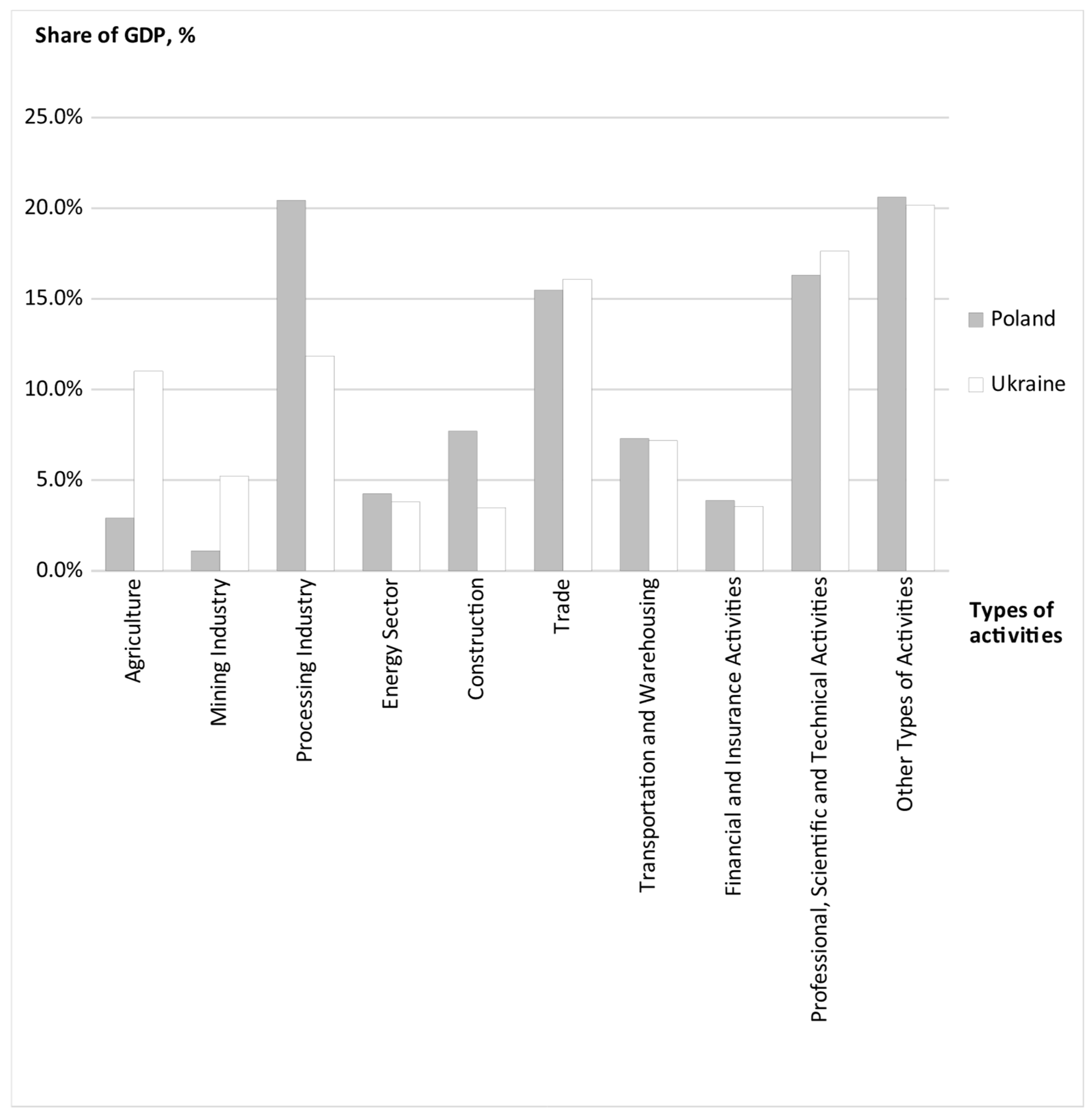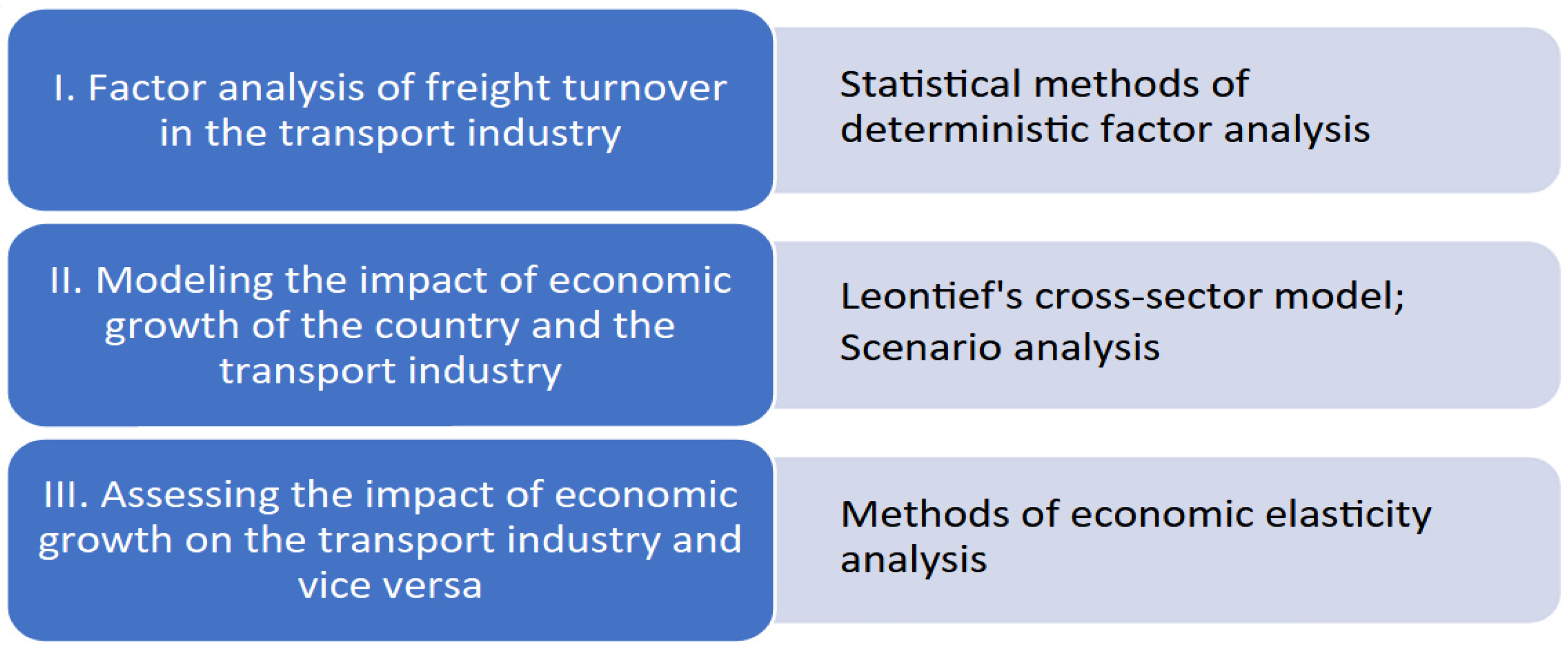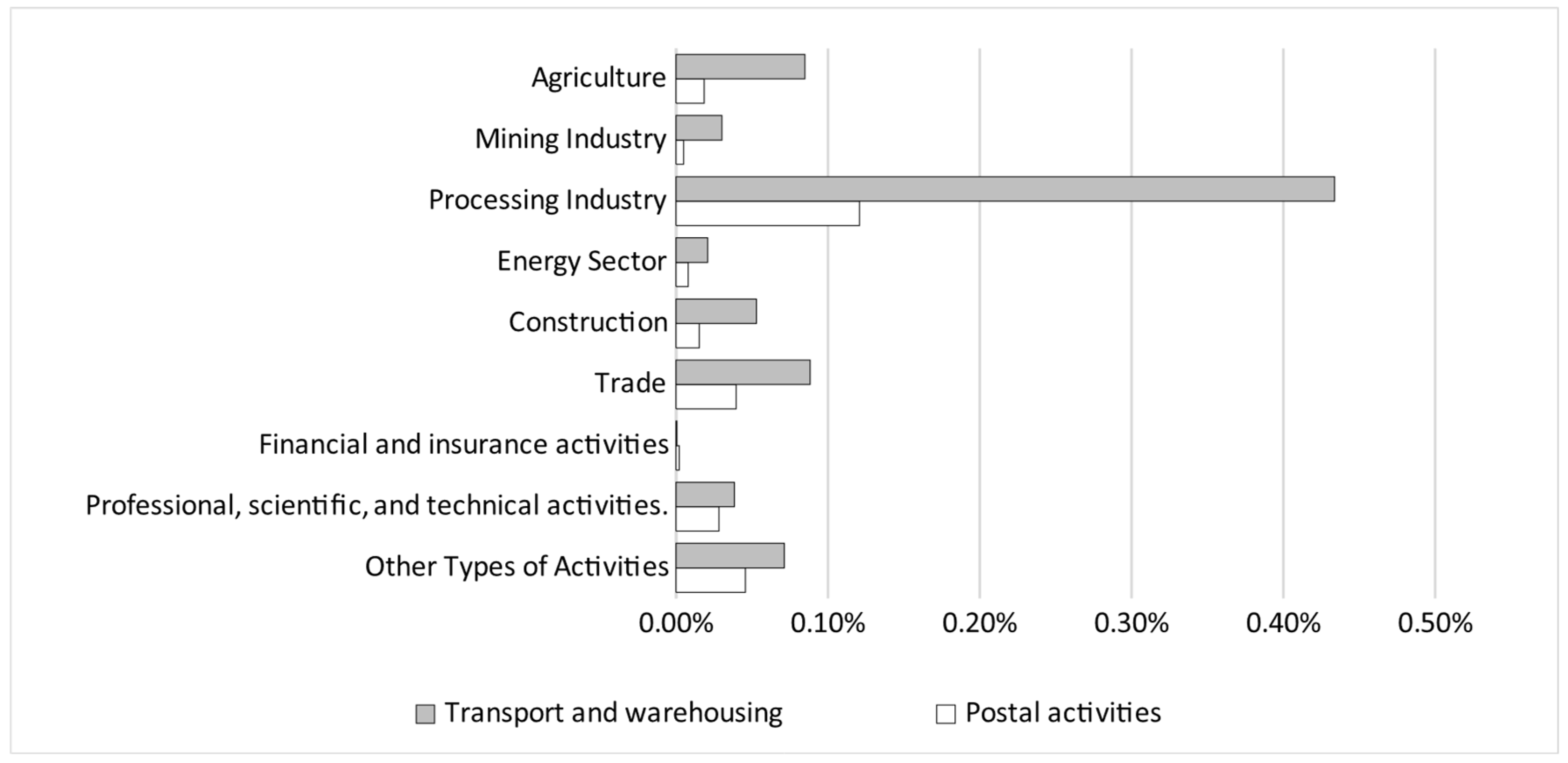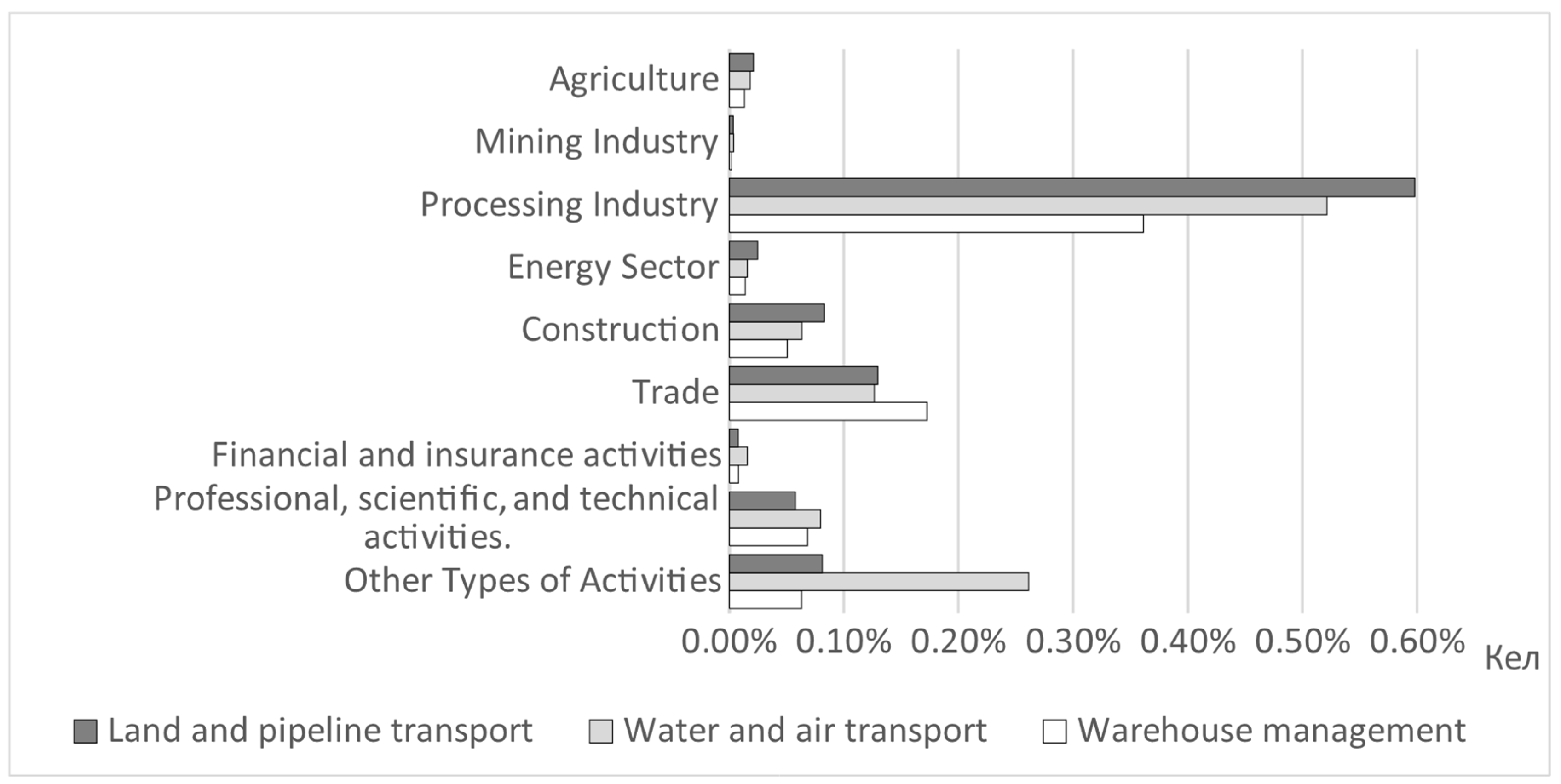Modeling Sustainable Development of Transport Logistics Under Climate Change, Ecosystem Dynamics, and Digitalization
Abstract
1. Introduction
1.1. Motivation and Objectives of the Study
1.2. The Role of Transport Infrastructure in Economic Development
2. Theoretical Framework and Methodology
2.1. Methodological Approaches to the Analysis of Transport Logistics and Ecosystem-Based Economic Development
2.2. Research Methodology
3. Results
3.1. Results for Ukraine
3.2. Results for Poland
- -
- A decrease in the capacity of transport networks due to factors that prevent their full operational utilization;
- -
- Economic losses caused by damage to cargo and transport infrastructure and the necessity of their restoration;
- -
- A deterioration in the safety of transport industry workers and passengers.
- Preventive measures:
- -
- Improvement of weather forecasting systems and timely communication of forecasts to transport services, companies, and passengers for appropriate planning and the implementation of precautionary measures;
- -
- Strengthening the resilience of transport infrastructure by using more durable construction materials, building drainage systems, reinforcing embankments, and applying other engineering solutions aimed at enhancing infrastructure resistance to extreme weather events;
- -
- Training personnel of transport services and companies in actions under extreme weather conditions;
- Active protection measures, which include the implementation of modern traffic safety technologies such as systems for monitoring road surface conditions, vehicle movement control systems, and navigation systems;
- Emergency response measures, which involve the preventive development and implementation of action plans in cases of hazardous weather conditions and the availability of specialized equipment for eliminating the consequences of natural disasters.
4. Discussion
5. Conclusions
Author Contributions
Funding
Institutional Review Board Statement
Informed Consent Statement
Data Availability Statement
Conflicts of Interest
References
- Kotenko, S.; Ilchenko, S.; Kasianova, V.; Kens, A. Risk assessment of water transport enterprises by modeling direct and indirect threats. Econ. Ecol. Socium 2023, 7, 15–25. [Google Scholar] [CrossRef]
- Maliuta, L.; Rudan, V.; Balushevskyj, K. Problems and perspectives of the development of transport logistics in Ukraine under the conditions of marital state. Econ. Anal. 2023, 33, 153–164. [Google Scholar] [CrossRef]
- Stopka, O.; Droździel, P.; L’upták, V. Modeling the designs in terms of logistics service center placement: A Case study. Arch. Transp. 2022, 64, 59–71. [Google Scholar] [CrossRef]
- Kordel, Z. Regulation of the road transport market in Poland. Zesz. Nauk. Uniw. Gdańskiego. Ekon. Transp. Logist. 2016, 58, 243–254. [Google Scholar]
- Kozak, L.S.; Fedoruk, O.V. Features of formation of an effective model of innovative development of the transport and road complex of Ukraine. Econ. State 2020, 3, 53–60. [Google Scholar] [CrossRef]
- Koźlak, A. The structure of the road transport sector in Poland and an assessment of its economic results compared to EU countries. Stud. Work. Coll. Manag. Financ. 2019, 166, 59–75. [Google Scholar] [CrossRef]
- Liu, L.; Anwar, A.; Irmak, E.; Pelit, I. Asymmetric linkages between public-private partnership, environmental innovation, and transport emissions. Econ. Res.-Ekon. Istraž. 2022, 35, 6519–6540. [Google Scholar] [CrossRef]
- Kosova, T.; Smerichevskyi, S.; Yaroshevska, O.; Mykhalchenko, O.; Raicheva, L. Organizational, financial, and informational restructuring in the system of demonopolization of the transport complex of Ukraine in the conditions of the knowledge economy. In Lecture Notes on Data Engineering and Communications Technologies; Springer: Cham, Switzerland, 2024; Volume 195. [Google Scholar] [CrossRef]
- Lorenc, A. Competitiveness of Polish road transport on the European market. Econ. Issues Serv. 2018, 1, 77–87. [Google Scholar] [CrossRef]
- Mashkantseva, S.O. Development of the region’s transport industry in the system of multimodal transportation. Ukr. J. Appl. Econ. 2018, 3, 331–336. [Google Scholar]
- Prus, P.; Sikora, M. The impact of transport infrastructure on the sustainable development of the region—Case study. Agriculture 2021, 11, 279. [Google Scholar] [CrossRef]
- Ogórek, M.; Strycharska, D. Strategic analysis of a company in the transport sector. Gospod. Mater. Logist. 2019, 12, 39–46. [Google Scholar] [CrossRef]
- Allen, T.; Arkolakis, C. The welfare effects of transportation infrastructure improvements. Rev. Econ. Stud. 2022, 89, 2911–2957. [Google Scholar] [CrossRef]
- Tijan, E.; Jović, M.; Aksentijević, S.; Pucihar, A. Digital transformation in the maritime transport sector. Technol. Forecast. Soc. Change 2021, 170, 120879. [Google Scholar] [CrossRef]
- Przybylska, E. Potential sources of innovation in the TSL industry. Zesz. Nauk. Politech. Śląskiej Ser. Organ. Zarządzanie 2017, 101, 401–410. [Google Scholar] [CrossRef]
- Sezer, M.D.; Ada, E.; Kazancoglu, Y. Investigating the key drivers in the transition to sustainable hydrogen transportation fuel. Econ. Ecol. Socium 2024, 8, 16–26. [Google Scholar] [CrossRef]
- Dobos, I.; Tóth-Bozó, B. Ecological footprint calculation as a land demand: Based on the dynamic Leontief model. Period. Polytech. Soc. Manag. Sci. 2024, 32, 103–114. [Google Scholar] [CrossRef]
- Zavidna, L.; Makarenko, P.M.; Chepurda, G.; Lyzunova, O.; Shmygol, N. Strategy of innovative development as an element to activate innovative activities of companies. Acad. Strateg. Manag. J. 2019, 18, 1–6. [Google Scholar]
- Bazan, L.I.; Kucha, D. Competitiveness of transport and logistics system in the period of digital transformation of the economy. Control Syst. Comput. 2023, 2, 27. [Google Scholar] [CrossRef]
- Sadowski, A.; Wąsowska, K.; Nowak, I. Logistics development in European countries: The case of Poland. Eur. Res. Stud. J. 2020, 23, 500–514. [Google Scholar] [CrossRef]
- Koval, V.; Nencheva, I.; Metil, T.; Honcharova, I.; Valiavska, N. Assessment of marketing affects on innovation advancement in the transport cluster. E3S Web Conf. 2024, 558, 01023. [Google Scholar] [CrossRef]
- Kaczorek, M.; Jacyna, M. Fuzzy logic as a decision-making support tool in planning transport development. Arch. Transp. 2022, 61, 51–70. [Google Scholar] [CrossRef]
- Koval, V.; Shmygol, N.; Đurović, S.; Pavićević, Đ.; Honcharova, I. Analysis of Innovative Electromobility Development and the Advancement of Eco-Friendly Transport Infrastructure. Sustainability 2025, 17, 1010. [Google Scholar] [CrossRef]
- Pivtorak, H.; Zhuk, M.; Gits, I.; Galkin, A. Shifting the population mobility of the Ukraine western region on the strength of the COVID-19 pandemic. Arch. Transp. 2022, 62, 7–32. [Google Scholar] [CrossRef]
- Prytula, K.; Maksymenko, A.; Kalat, Y.; Kyryk, I.M. Development of the logistics and transport infrastructure of the border regions of Western Ukraine in the context of deepening integration with the European Union. Reg. Econ. 2023, 2, 60–71. [Google Scholar] [CrossRef]
- Shkurenko, O.; Savchenko, M. Strategy of development of logistic infrastructure of Ukraine in the conditions of European integration. SHS Web Conf. 2019, 67, 06046. [Google Scholar] [CrossRef]
- Khvedelidze, P.; Sokolov, A.; Klenin, O.; Hryshyna, L. Strategic Management of Sustainable Economic Development in Transport and Logistics Sector Companies. Econ. Ecol. Socium 2024, 8, 99–108. [Google Scholar] [CrossRef]
- Pradhan, R.P.; Arvin, M.B.; Nair, M. Urbanization, transportation infrastructure, ICT, and economic growth: A temporal causal analysis. Cities 2021, 115, 103213. [Google Scholar] [CrossRef]
- Jacyna-Gołda, I.; Shmygol, N.; Gavkalova, N.; Salwin, M. Sustainable development of intermodal freight transportation—Through the integration of logistics flows in Ukraine and Poland. Sustainability 2024, 16, 267. [Google Scholar] [CrossRef]
- Zimon, G. Analiza kosztów w przedsiębiorstwach transportu samochodowego. Zesz. Nauk. Uniw. Szczec. 2015, 873, 349–354. [Google Scholar] [CrossRef]
- Central Statistical Office. Annual National Accounts. 2020. Available online: https://stat.gov.pl/obszary-tematyczne/rachunki-narodowe/roczne-rachunki-narodowe/ (accessed on 29 June 2025).
- Nikolova-Alexieva, V.; Alexieva, I.; Valeva, K.; Petrova, M. Model of the Factors Affecting the Eco-Innovation Activity of Bulgarian Industrial Enterprises. Risks 2022, 10, 178. [Google Scholar] [CrossRef]
- State Statistics Service of Ukraine. National Accounts. 2020. Available online: https://www.ukrstat.gov.ua/operativ/menu/menu_u/nac_r.htm (accessed on 20 March 2025).
- Azimov, D.T.; Petrova, M. Determination of the efficiency of implementing blockchain technology into the logistics systems. Bus. Manag. 2022, 32, 52–67. [Google Scholar]
- Sałaciński, T.; Chrzanowski, J.; Chmielewski, T. Statistical Process Control Using Control Charts with Variable Parameters. Processes 2023, 11, 2744. [Google Scholar] [CrossRef]




| Freight Turnover by Different Modes of Transport, Billion Tkm | Year | ||||
|---|---|---|---|---|---|
| Total | Other | Pipeline | Road | Railway | |
| 344.2 | 4.2 | 94.4 | 58.0 | 187.6 | 2016 |
| 364.2 | 4.6 | 105.4 | 62.3 | 191.9 | 2017 |
| 361.3 | 3.7 | 99.2 | 72.1 | 186,3 | 2018 |
| 355.0 | 3.7 | 104.5 | 65.0 | 181,8 | 2019 |
| 313.2 | 3.1 | 69.3 | 65.2 | 175,6 | 2020 |
| Freight Turnover by Different Modes of Transport, Billion Tkm | Year | ||||
|---|---|---|---|---|---|
| Total | Other | Pipeline | Road | Railway | |
| 385.7 | 9.3 | 22.2 | 303.6 | 50.7 | 2016 |
| 434.9 | 10.5 | 21.1 | 348.6 | 54.8 | 2017 |
| 467.2 | 8.7 | 21.3 | 377.8 | 59.4 | 2018 |
| 477.1 | 7.9 | 19.4 | 395.3 | 54.6 | 2019 |
| 474.6 | 7.4 | 20.4 | 395.6 | 51.1 | 2020 |
| … | … | … | … | … | … |
| 494.6 | 20.6 | 12.3 | 400.6 | 61.1 | 2023 |
| Weather Conditions | Water Transport | Air Transport | Rail Transport | Road Transport |
|---|---|---|---|---|
| Snowfalls, blizzards, and ice | Ice conditions block navigation, increase transport time and fuel consumption, lead to ship stability issues. | Ice accumulation degrades aerodynamics, increases weight, leads to loss of lift and controllability. | Snowdrifts, icing of switch points and overhead lines cause railway delays and braking issues, and require snow removal. | Increased braking distance, difficulty in vehicle control, and increased accident risk. Snowdrifts can block traffic, cause jams, and disrupt logistics chains. |
| Heavy rains and floods | Floods and droughts limit navigability, affecting inland water transport; crew issues on open decks. | Lightning damage to electronics, strong winds and hail physically damage aircraft, aquaplaning on runways. | Railway track washouts, embankment damage, track flooding making movement dangerous or impossible. | Reduced visibility, aquaplaning risk, extended braking distance, decreased highway speed by 10–15%. |
| Fog | Visibility restrictions complicating navigation, increasing collision and grounding risks; port delays. | Visibility restrictions complicating takeoff and landing, especially without modern navigation systems. | Visibility restrictions complicating train operations and signal recognition, causing speed limitations. | Visibility restrictions causing traffic accidents. |
| Strong wind | Complicated ship control, increased voyage time, cargo and equipment damage. | Headwinds increase flight time and fuel consumption; crosswinds complicate takeoff and landing. | Dangerous for empty wagons and high-speed trains; can cause derailments. | Loss of control of large vehicles on open roads and bridges. |
| Extreme temperatures (heat and frost) | High temps affect crew and equipment; low temps cause pipeline freezing, deck icing, hazardous work conditions. | High temps reduce lift; low temps impact engines and hydraulics. | High temps deform tracks; low temps cause metal brittleness, requiring speed restrictions or closures. | High temps destroy asphalt, overheat engines; low temps cause starting and brake system issues. |
Disclaimer/Publisher’s Note: The statements, opinions and data contained in all publications are solely those of the individual author(s) and contributor(s) and not of MDPI and/or the editor(s). MDPI and/or the editor(s) disclaim responsibility for any injury to people or property resulting from any ideas, methods, instructions or products referred to in the content. |
© 2025 by the authors. Licensee MDPI, Basel, Switzerland. This article is an open access article distributed under the terms and conditions of the Creative Commons Attribution (CC BY) license (https://creativecommons.org/licenses/by/4.0/).
Share and Cite
Jacyna-Gołda, I.; Shmygol, N.; Sembiyeva, L.; Cherniavska, O.; Burtebayeva, A.; Uskenbayeva, A.; Salwin, M. Modeling Sustainable Development of Transport Logistics Under Climate Change, Ecosystem Dynamics, and Digitalization. Appl. Sci. 2025, 15, 7593. https://doi.org/10.3390/app15137593
Jacyna-Gołda I, Shmygol N, Sembiyeva L, Cherniavska O, Burtebayeva A, Uskenbayeva A, Salwin M. Modeling Sustainable Development of Transport Logistics Under Climate Change, Ecosystem Dynamics, and Digitalization. Applied Sciences. 2025; 15(13):7593. https://doi.org/10.3390/app15137593
Chicago/Turabian StyleJacyna-Gołda, Ilona, Nadiia Shmygol, Lyazzat Sembiyeva, Olena Cherniavska, Aruzhan Burtebayeva, Assiya Uskenbayeva, and Mariusz Salwin. 2025. "Modeling Sustainable Development of Transport Logistics Under Climate Change, Ecosystem Dynamics, and Digitalization" Applied Sciences 15, no. 13: 7593. https://doi.org/10.3390/app15137593
APA StyleJacyna-Gołda, I., Shmygol, N., Sembiyeva, L., Cherniavska, O., Burtebayeva, A., Uskenbayeva, A., & Salwin, M. (2025). Modeling Sustainable Development of Transport Logistics Under Climate Change, Ecosystem Dynamics, and Digitalization. Applied Sciences, 15(13), 7593. https://doi.org/10.3390/app15137593






